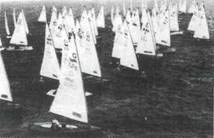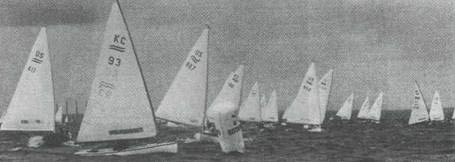| 16. Gold Cup
1971 |
Toronto,
Canada, October 1-9, 87 entries from 21 countries
|
|
 |
Because of new entry regulations and the poor reachability only 87 entries from 21 countries had arrived. Rickard Sarby was watching the races. After winning the North
Americans just before the Gold Cup some misfortune in the first race (capsizing)
made Jorg Bruder mad as a bull and he won by several hundred meters in the
20 knot wind. The next day Bruder was leading in a 20 knots wind again,
when he tried to gybe with his boom vang still tight and capsized again.
But he regained the lead and won again. A fierce duel between Carl van Duyne
and Jorg in the next race ended with a narrow victory of Bruder after the
lead changed 10 times.
|
In the last race Bruder played it safe in the middle of the fleet, while Carl van Duyne gambled on a shift and won the race but not the Cup. On the last reach Carl tried all sort of tricks to slow down Bruder - overstanding the lay line and luffing like mad, but still had to finish ahead of Jorg. But finally Carl finished first and Bruder second, thus winning the Gold Cup for the second time.
|
 |
|
17. Gold Cup 1972 |
Anzio,
Italy, June 25 - July 1, 103 entries from 25 countries
|
|
For the first and perhaps last time in its 3C years of existence the
Firm Gold Cup was won in three consecutive years by one man. Jorg
Bruder from Brazil took the world championship again. This time Jorg
used a new aluminium mast which he had developed similar to his successful
wooden spars. He borrowed the Canadian '71 Raudaschl sail which had
used to win the 1971 Gold Cup. Bruder's speed was normal however he
pointed higher with the new mast which was more flexible sideways
at the top than the Needlespar masts. Bruder's final score line of
2/3/2/1/4/6 is most impressive.
|
 |
| The
fleet in 1972 |
|
The 1972 Gold Cup was held in Anzio - 25 miles south of Rome - in typical
Mediterranean weather. The winds were generally light at the beginning of
the week but the last two races were sailed in a moderate westerly wind
which produced a very big swell. These last two races were won in a most
masterly manner by the Australian Olympic Finn helmsman John Bertrand, who
was in front for the whole of the two races. He gradually moved further
ahead, winning by over two minutes each race. Bertrand used the Olympic
rig of a Needlespar mast and North sail on an Australian glassfibre hull.
Certainly at the end of the week he was unbeatable in speed and tactics.
But the lighter winds at the beginning showed a different winner each day
and it was during this period that Bruder worked out an unassailable points
lead, with consistent placings in the first three.
|
The first race of the regatta was led home by the former world champion
and winner of Kiel Week in 1972, Thomas Lundquist of Sweden who desperately
held off Bruder's last leg challenge. Fabio Albarelli of Italy, the
bronze medalist at Acapulco, won the second race and the Swede, Lennart
Gustafsson, the third.
|
 |
|
Finally in the light
wind fourth race Bruder took the winner's gun and increased his overall
lead to an unassailable position. After his fifth race fourth place his
only danger lay from Gustafsson, who could take the championship if he won
and Bruder finished worse than fourth. In any event the last race was simple
for Bruder as Gustafsson had a bad start and could never climb out of the
pack. There had been little change on the fittings and gear side with one
big exception; the universal acceptance of aluminium spars. A year previously
the whole of the Finn class was against the introduction of aluminium; this
year one third of the fleet sported metal masts and, to cap it all, aluminium
masts finished first and second. |
18. Gold Cup 1973 |
Brest,
France, July 14-23, 103 entries from 20 countries
|
|
Brest turned out to be unsuitable for a major international regatta and
was certainly not within the rules laid down for the Gold Cup. The IFA had
approved of Brest on the understanding that the course would be set on the
open sea outside. But instead, sailing was organised inside the harbour.
One side of the course was far too close to the maximum tidal stream through
the harbour entrance. Vernon Stratton brought along a new double-bottom
boat which received approval of the Measurement and Technical Committee.
For the first time extensive Lamboley tests were used. The Lanaverres and
Teels had the lowest permissible results, the Raudaschls performed
mediocre.
|
Almost all the front runners were using metal spars, Maury
a Bruder-Alu mast, most others Needlespars. In the strongest winds
wooden spars still proved to be superior. But the event was overshadowed
by the death of Jorg Bruder who was killed in an air crash approaching
Paris in order to defend the title. Nobody dominated as was the case
in previous years and six different sailors look line honours. Before
the last race Liljegren was leading in front of Olin and Maury. But
Maury won the Cup by finishing second in front of Olin who was 4th
and Liljegren who was 8th. |
 |
| Serge
Maury, winner in 1973 |
|
Final Results Gold Cup 1971 |
Final
Results Gold Cup 1972 |
Final
Results Gold Cup 1973 |
| 1.
Jorg Bruder |
BL
3 |
33.0 |
| 2.
Carl Van Dyne |
US
245 |
34.0 |
| 3.
Serge Maury |
F7 |
51.7 |
| 4.
Ed Bennett |
US
534 |
69.7 |
| 5.
Thomas Lundquist |
S
532 |
74.0 |
| 6. Thomas
Jungblut |
G
1146 |
77.0 |
| 7. Goran
Andersson |
S
516 |
79.7 |
| 8. Bret
De Thier |
KZ
133 |
89.7 |
| 9. John
Bertrand |
KA
111 |
92.7 |
| 10.G.
Dahlstrom |
S
156 |
99.7 |
| 11.
Arne Akerson |
S
321 |
115.0 |
| 12.
Lennart Gustafsson |
S
589 |
112.0 |
| 13.
Magnus Olin |
S
509 |
116.7 |
| 14.
Henry Sprague |
US
896 |
115.4 |
| 15.
Guy Liljegren |
S
554 |
129.0 |
| 16.
Robbie Doyle |
US
411 |
137.0 |
| 17.
Gordy Bowers |
US
902 |
139.0 |
| 18.
P.Akerson |
S
32 |
139.7 |
| 19.
Robert Andre |
US
830 |
142.0 |
| 20.
John Clarke |
КС
111 |
146.0 |
| 21.
Hubert Raudaschl |
OE
131 |
149.0 |
| 22.
V. Neudoeffer |
КС
93 |
155.0 |
| 23.
Richard Storer |
КС
300 |
156.0 |
| 24.
Patrick Pym |
К
274 |
163.0 |
| 25.
Hans Fogh |
D
104 |
164.0 |
| 26.
Hans Werner Zachariassen |
G
1160 |
164.0 |
| 27.
Chris Law |
К
321 |
164.4 |
| 28.
Walter Mai |
G
1171 |
196.4 |
| 29.
Andy Zawieja |
PZ
321 |
171.0 |
|
| 1. Jorg
Bruder |
BL3 |
19.7 |
| 2. John
Bertrand |
KA113 |
32.0 |
| 3. Lennart
Gustafsson |
S589 |
33.7 |
| 4. Fabio
Albarelli |
1465 |
50.4 |
| 5. Thomas
Lundquist |
S532 |
65.7 |
| 6. Kim
Weber |
L161 |
70.4 |
| 7. Magnus
Olin |
S509 |
75.0 |
| 8. Elias
Hatzipavlis |
GR
164 |
84.7 |
| 9. John
Clarke |
КС
111 |
93.7 |
| 10.
Bill Holmstrom |
L146 |
105.0 |
| 11.
Mikael Brandt |
S389 |
114.0 |
| 12.
Tom Sandberg |
S594 |
115.7 |
| 13.
Mauro Pelaschier |
1460 |
117.0 |
| 14.
Kent Carlsson |
S584 |
122.0 |
| 15.
A. Papaioannou |
GR
165 |
125.0 |
| 16.
Baudouin Binkhorst |
H454 |
128.0 |
| 17.
Heilmut Duckeroff |
G1269 |
129.0 |
| 18.
Minski Fabris |
Y30 |
134.0 |
| 19.
Luciano Lievi |
1417 |
135.0 |
| 20.
lain MacDonald-Smith |
К
267 |
139.0 |
| 21.
Miroslav Vejvoda |
CZ
111 |
141.0 |
| 22.
Torbjorn Ahlback |
L145 |
141.7 |
| 23.
Giorgio Gorla |
1435 |
146.0 |
| 24.
Fritz Gels |
G1100 |
147.0 |
| 25.
Guy Liljegren |
S4 |
152.0 |
| 26.
Rolf Beck |
G
1268 |
167.0 |
| 27.
Kazuoki Matsyuama |
J
15 |
168.0 |
| 28.
Bo Rogberg |
S398 |
172.0 |
| 29.
Claudio Biekarck |
BL
10 |
174.0 |
| 30.
Christian Cuccurullo |
F651 |
176.0 |
| 31.
Magnus Lidholm |
S583 |
177.0 |
| 32.
Kevin MacLaverty |
IR
21 |
182.0 |
| 33.
Sanford Riley |
КС
143 |
183.0 |
|
| 1. Serge
Maury |
Fl |
42.7 |
| 2. Magnus
Olin |
S584 |
44.7 |
| 3. Guy
Liljegren |
S554 |
46.7 |
| 4. Lennart
Gustafsson |
S589 |
64.0 |
| 5. Lou
Nady |
US
150 |
73.0 |
| 6. Alex
Welter |
BL
5 |
73.4 |
| 7. Bernt
Johnsson |
S521 |
91.7 |
| 8. Jacques
Busquet |
F196 |
98.7 |
| 9. David
Schmidt |
KZ111 |
99.0 |
| 10.
Kent Carlsson |
S509 |
104.0 |
| 11.
G.Ehlers |
G1277 |
110.0 |
| 12.
J.P. Boumans |
Bl |
114.0 |
| 13.
P. Mondeteguy |
F6 |
133.0 |
| 14.
Claudio Biekarck |
BL
10 |
137.0 |
| 15.
Jonty Farmer |
KZ
149 |
139.7 |
| 16.
Mauro Pelaschier |
1460 |
150.0 |
| 17.
Bernhard Reist |
Z224 |
156.0 |
| 18.
Richard Hart |
К
331 |
157.0 |
| 19.
Prenat |
F435 |
159.0 |
| 20.
Thomas Jungblut |
G1335 |
161.0 |
| 21.
Robert Holbrook |
K351 |
162.0 |
| 22.
Mikael Brandt |
S389 |
165.0 |
| 23.
David Howlett |
К
341 |
166.0 |
| 24.
Werner Sulberg |
G1169 |
170.0 |
| 25.
Jean Grandchamp |
F700 |
175.0 |
| 26.
Patrice Charee |
F8 |
182.0 |
| 27.
Kees Douze |
H7 |
182.0 |
| 28.
Achim Turklitz |
G1270 |
184.0 |
| 29.
Craig Thomas |
US
934 |
185.0 |
| 30.
Tiemen de Vries |
H500 |
188.7 |
| 31.
J.G. Pasturaud |
F675 |
192.7 |
| 32.
Chedeville |
F60 |
204.0 |
|
|